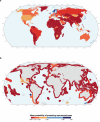The socioeconomic and environmental niche of protected areas reveals global conservation gaps and opportunities
- PMID: 39424792
- PMCID: PMC11489723
- DOI: 10.1038/s41467-024-53241-1
The socioeconomic and environmental niche of protected areas reveals global conservation gaps and opportunities
Abstract
The global network of protected areas has rapidly expanded in the past decade and is expected to cover at least 30% of land and sea by 2030 to halt biodiversity erosion. Yet, the distribution of protected areas is highly heterogeneous on Earth and the social-environmental preconditions enabling or hindering protected area establishment remain poorly understood. Here, using fourteen socioeconomic and environmental factors, we characterize the multidimensional niche of terrestrial and marine protected areas, which we use to accurately establish, at the global scale, whether a particular location has preconditions favourable for paestablishment. We reveal that protected areas, particularly the most restrictive ones, over-aggregate where human development and the number of non-governmental organizations are high. Based on the spatial distribution of vertebrates and the likelihood to convert non-protected areas into strictly protected areas, we identify 'potential' versus 'unrealistic' conservation gains on land and sea, which we define as areas of high vertebrate diversity that are, respectively, favourable and unfavourable to protected area establishment. Where protected areas are unrealistic, alternative strategies such as other effective area-based conservation measures or privately protected areas, could deliver conservation outcomes.
© 2024. The Author(s).
Conflict of interest statement
The authors declare no competing interests.
Figures






References
-
- Sala, E. et al. Protecting the global ocean for biodiversity, food and climate. Nature592, 397–402 (2021). - PubMed
-
- Ban, N. C. et al. Well-being outcomes of marine protected areas. Nat. Sustain.2, 524–532 (2019).
-
- Gill, D. A. et al. Capacity shortfalls hinder the performance of marine protected areas globally. Nature543, 665–667 (2017). - PubMed
Publication types
MeSH terms
LinkOut - more resources
Full Text Sources
Miscellaneous

